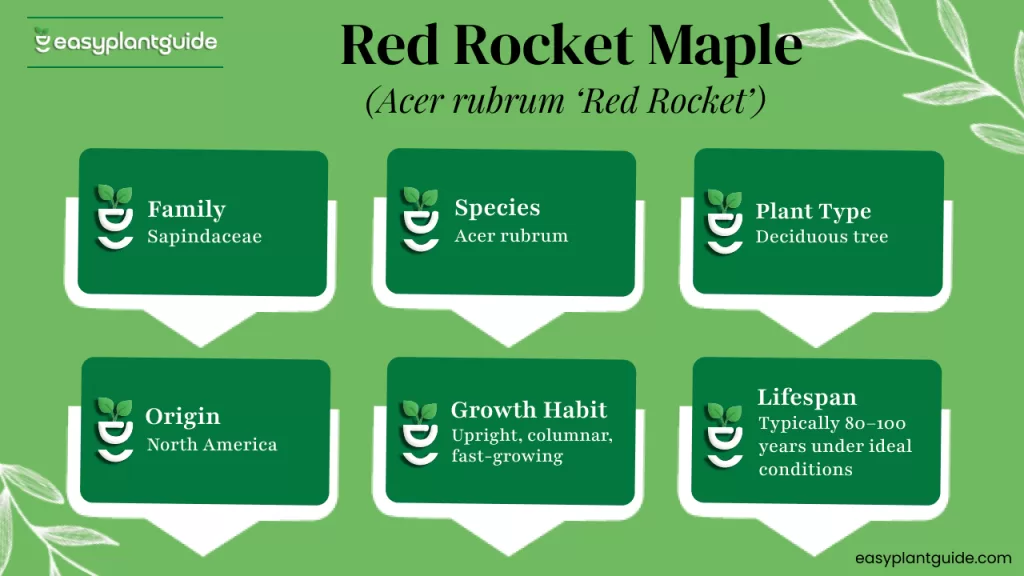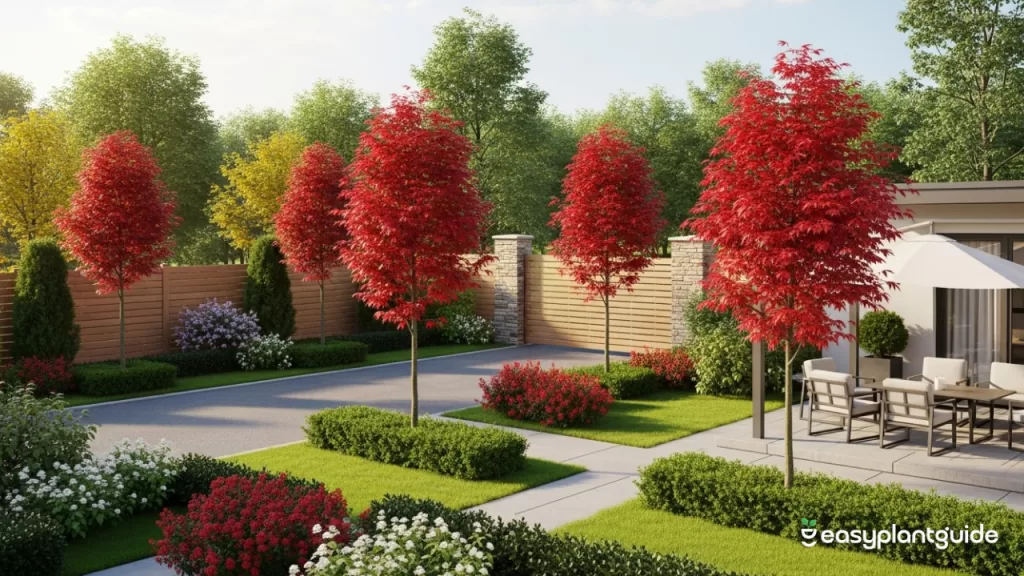Red Rocket Maple: 7 Stunning Reasons You’ll Love This Tree
If you’ve ever dreamed of a tree that paints your yard in shades of crimson, the Red Rocket Maple (Acer rubrum ‘Red Rocket’) is your ticket to a year-round show. This tree isn’t just another maple—it’s a fast-growing, narrow, and vibrant powerhouse that brings color, structure, and elegance to any landscape. Whether you’re a beginner gardener or a seasoned plant lover, you’re going to fall head over heels for this beauty.

What Is the Red Rocket Maple?
The Red Rocket Maple is a stunning cultivar of the Red Maple (Acer rubrum) family, admired for its narrow, upright growth and brilliant red fall foliage. Unlike wider maple varieties, it fits beautifully in compact spaces, making it perfect for urban gardens, driveways, or small landscapes. This deciduous tree thrives in USDA Zones 4–8, reaching a mature height of 35–45 feet with a spread of about 12–15 feet. Its strong trunk, symmetrical shape, and vibrant seasonal colors bring both elegance and structure to any outdoor space.
The Perfect Growing Conditions
- Soil: Prefers moist, well-drained soil but tolerates clay.
- Sunlight: Full sun for best color (at least 6 hours daily).
- Water: Regular watering during the first few years.
- Temperature: Hardy to -30°F, perfect for cold climates.
Planting Red Rocket Maple the Right Way
Planting a Red Rocket Maple is simple and rewarding if you follow a few key steps. Start by choosing a sunny location with well-drained soil, as this tree thrives best in full sun. Dig a hole twice as wide as the root ball, giving the roots plenty of room to spread and establish. When placing the tree, make sure it sits at ground level—never bury the trunk, as this can lead to rot.
Next, fill the hole with soil, pressing gently to eliminate any air pockets that could hinder root growth. Water the tree deeply right after planting to help it settle, and finish by adding a layer of mulch to retain moisture and regulate soil temperature.
Avoid planting too close to driveways or sidewalks, since the roots like to stretch outward as the tree matures. With proper planting, your Red Rocket Maple will establish quickly and reward you with vibrant growth season after season.
Environmental Benefits
Beyond its stunning appearance, the Red Rocket Maple also contributes significantly to the environment. This tree doesn’t just beautify your space—it actively supports nature’s balance and overall ecosystem health.
1. Absorbs Carbon Dioxide Efficiently
Like all maples, the Red Rocket is a natural air purifier. It absorbs large amounts of carbon dioxide and releases clean oxygen, helping reduce greenhouse gases and improve the air you breathe.
2. Provides Shade and Reduces Urban Heat
Its broad canopy offers cooling shade during hot months, lowering surrounding temperatures. When planted in urban areas, this helps combat the urban heat island effect, making cities cooler and more livable.
3. Offers Shelter and Food for Birds
The Red Rocket Maple serves as a natural habitat for birds and small wildlife. Its branches provide shelter, while its seeds and insects offer a reliable food source throughout the year.
4. Improves Soil Structure
With its fibrous root system, the tree enhances soil aeration and drainage, preventing erosion and compaction. Over time, this improves the overall fertility and structure of the soil.
5. Enhances Air Quality
Besides filtering carbon dioxide, this maple captures dust, pollen, and airborne pollutants, keeping the air fresher and cleaner. It’s a silent worker that continuously improves your outdoor environment.
Seasonal Beauty – A Year-Round Performer
The Red Rocket Maple is truly a tree for all seasons, changing its appearance like a natural work of art throughout the year. In spring, it bursts to life with fresh green leaves and clusters of tiny red flowers that signal the start of a new growing season. As summer arrives, the tree develops a dense, rich green canopy that provides cool, refreshing shade—perfect for relaxing beneath on warm days.
When fall comes, the Red Rocket Maple steals the spotlight with its explosive display of fiery red foliage, creating a breathtaking scene that lasts for weeks. Even in winter, when most trees fade into the background, its smooth gray bark and elegant upright form add structure and contrast to the landscape. No matter the season, this maple remains a standout feature, offering year-round color, texture, and visual appeal.
Common Problems and Solutions
| Problem | Cause | Solution |
|---|---|---|
| Leaf scorch | Drought or heat stress | Water deeply and mulch |
| Chlorosis | Alkaline soil | Add sulfur or iron chelate |
| Aphids | Insect infestation | Use neem oil spray |
| Root girdling | Poor planting | Replant properly or prune roots |
Red Rocket Maple Root System
The Red Rocket Maple develops a strong yet shallow root system that spreads close to the soil surface. While its roots are not aggressive enough to damage foundations, they can extend outward in search of water and nutrients. To prevent any interference with pavements or driveways, it’s best to plant the tree at least 6–8 feet away from hard surfaces. This spacing allows the roots to grow freely and ensures the tree remains stable and healthy for years.
Pruning Tips for Shape and Health
Regular pruning keeps your Red Rocket Maple in top form, encouraging healthy growth and a balanced shape. Begin by removing any dead, damaged, or crossing branches to improve airflow and reduce disease risk. Lightly thin out the canopy to let sunlight filter through, but avoid cutting too much at once, as heavy pruning can stress the tree. Always disinfect your pruning tools before use to prevent the spread of infections. A gentle, minimal approach will keep your maple looking tidy and naturally elegant.
Propagation – Grow More Red Rockets
If you’d like to expand your collection, propagating the Red Rocket Maple is a fun and rewarding option. The easiest method is through cuttings—take semi-hardwood cuttings during summer and root them in moist, well-drained soil until established. Alternatively, you can grow new trees from seeds by stratifying them in a cool, moist environment for about two to three months before planting. While seed propagation takes longer, cuttings ensure identical offspring, preserving the same color, shape, and growth traits as the parent tree.
Caring for Your Red Rocket Maple
Once your Red Rocket Maple is planted, maintenance becomes refreshingly easy. This hardy and adaptable tree doesn’t demand constant attention, but a little care goes a long way. Here’s how to keep it strong, colorful, and thriving for years to come.
1. Water Regularly During Dry Spells
Consistent watering is key, especially during the first few years. Deep watering helps roots grow strong and stable. In dry or hot weather, aim to water once a week to keep the soil moist but not soggy.
2. Mulch to Retain Soil Moisture
Adding a 2–3 inch layer of mulch around the base helps retain moisture, regulate soil temperature, and prevent weeds. Keep the mulch a few inches away from the trunk to avoid rot and promote healthy airflow.
3. Fertilize in Early Spring
If your soil is lacking nutrients, apply a balanced, slow-release fertilizer in early spring. This gives your tree an energy boost right before the growing season begins, ensuring rich foliage and steady growth.
4. Prune in Late Winter or Early Spring
Pruning is best done when the tree is dormant. Remove dead, damaged, or crossing branches to improve air circulation and shape. Light pruning helps maintain its upright form without stressing the tree.
5. Watch for Pests and Insects
Although the Red Rocket Maple is generally pest-resistant, it can occasionally attract aphids or scale insects. Check leaves and stems regularly, and if needed, treat infestations with natural insecticidal soap or neem oil.
Red Rocket Maple in Landscaping

This tree adds vertical drama to your garden design. Its slim silhouette fits beautifully in both modern and traditional landscapes. You can use it:
- Along driveways for a uniform look
- Near fences for natural privacy
- In small yards for height without crowding
- As a backdrop for flowering shrubs
- Beside patios to provide partial shade
Best Companion Plants
Pairing your Red Rocket Maple with the right companion plants can elevate your landscape design, creating layers of color, texture, and balance. Choose plants that complement its fiery red foliage and slender, upright form for a cohesive and eye-catching garden. Here are some great options to consider:
- Hydrangeas for soft contrast: Their large, pastel blooms create a gentle balance against the maple’s bold red tones, especially during late spring and summer.
- Hostas for shade areas: Perfect for planting beneath the maple, hostas add lush green foliage and thrive in the dappled shade it provides.
- Ornamental grasses for movement: Their graceful, flowing blades add texture and motion, contrasting beautifully with the maple’s structured form.
- Dogwoods for multi-season interest: With colorful bark, blossoms, and berries, dogwoods complement the maple’s seasonal charm all year long.
- Tulips for a burst of spring color: These early bloomers bring vibrant hues at the base of the maple, creating a striking springtime display before its leaves fully appear.
Red Rocket Maple vs. Other Red Maples
| Maple Variety | Height (ft) | Spread (ft) | Fall Color | Growth Rate | Shape |
|---|---|---|---|---|---|
| Red Rocket Maple | 35–45 | 12–15 | Bright Red | Fast | Columnar |
| October Glory Maple | 40–50 | 35–40 | Deep Red | Moderate | Rounded |
| Red Sunset Maple | 45–50 | 35–40 | Orange-Red | Moderate | Oval |
| Autumn Blaze Maple | 50–55 | 40–45 | Scarlet | Very Fast | Broad |
Why Gardeners Love Red Rocket Maple
There are countless trees to choose from, but few combine beauty, strength, and versatility like the Red Rocket Maple. Its brilliant red foliage in fall transforms any yard into a scene straight out of a painting, creating a burst of color that lasts for weeks. Gardeners appreciate how quickly it grows with minimal maintenance, saving time while still delivering a lush, mature look. The narrow, upright form makes it ideal for small yards, driveways, and city landscapes, where space is limited but style is essential.
Beyond its looks, this maple is remarkably tolerant of different soil types, adapting well to clay, loam, or even slightly wet ground. It’s also a wildlife-friendly tree, attracting birds, bees, and pollinators that enhance the natural balance of your outdoor space. With its mix of durability and beauty, it’s no surprise the Red Rocket Maple is a favorite among gardeners who want both practicality and year-round charm.
Conclusion – The Tree That Redefines Beauty
If you’re looking for a tree that combines grace, color, and strength, the Red Rocket Maple deserves a prime spot in your yard. From its blazing red fall display to its sleek, space-saving form, this maple is proof that nature can be both bold and practical. Plant one today, and every autumn, you’ll be rewarded with a skyline of fire-red leaves that’ll make your neighbors stop and stare. It’s not just a tree—it’s a statement.
Explore more plant blogs and grow your green journey with us.




